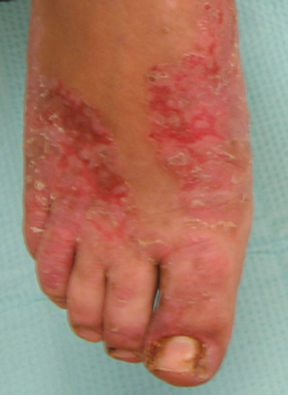History and exam
Key diagnostic factors
common
presence of risk factors
Key risk factors include living in a developing region; malabsorption syndromes; chronic gastrointestinal and liver disease; renal disease; sickle cell disease; HIV infection; chronic treatment with certain medications (hydrochlorothiazide, penicillamine, ethambutol, certain antibiotics); age >65 years; alcoholism; vegetarian or vegan diet.[8][7][10][11][28][31][50] A family history of severe zinc deficiency is suggestive of acrodermatitis enteropathica (autosomal-recessive inheritance).
increased susceptibility to infection
Zinc deficiency in many populations, especially children and older people, has been associated with increased risk and severity of infection.
taste disorders
Zinc deficiency can lead to quantitative or qualitative taste disorders such as taste reduction, taste loss, or dysgeusia.[51]
stomatitis
Stomatitis is one of the more common dermatological manifestations of zinc deficiency but is quite non-specific.
uncommon
delayed wound healing
Unusually delayed wound healing should prompt testing for zinc deficiency.
acrodermatitis enteropathica
Typically presents in infancy with crusting, vesicular dermatitis, diarrhoea, impairment of growth, and infections. Severe rash of acrodermatitis enteropathica seen in profound zinc deficiency.[Figure caption and citation for the preceding image starts]: Acrodermatitis enteropathica seen with severe zinc deficiencyAdapted from Maverakis E, Lynch PJ, Fazel N. Acrodermatitis enteropathica. Dermatol Online J. 2007;13:11; used with permission [Citation ends]. [Figure caption and citation for the preceding image starts]: Acrodermatitis enteropathica on the face seen with severe zinc deficiencyAdapted from Maverakis E, Lynch PJ, Fazel N. Acrodermatitis enteropathica. Dermatol Online J. 2007;13:11; used with permission [Citation ends].
[Figure caption and citation for the preceding image starts]: Acrodermatitis enteropathica on the face seen with severe zinc deficiencyAdapted from Maverakis E, Lynch PJ, Fazel N. Acrodermatitis enteropathica. Dermatol Online J. 2007;13:11; used with permission [Citation ends].
Other diagnostic factors
common
fatigue
The clinical features of zinc deficiency are highly non-specific.
gastrointestinal symptoms
Include anorexia, abdominal pain, diarrhoea, glossitis; however, these symptoms are very non-specific.
short stature
Zinc deficiency in the population of a developing country is often more severe than that seen in developed countries. Faltering growth and hypogonadism are common consequences.[24]
While these signs are rarely obvious in developed countries, mild zinc deficiency may commonly lead to mild growth impairment. There is some evidence that supplementation with zinc may benefit child growth, particularly in areas where deficiency is common.[37][38]
[  ]
[Evidence A]
]
[Evidence A]
bone fracture
Zinc deficiency has been postulated to contribute to osteopenia (low bone mineral density), though evidence for the efficacy of supplementation is lacking.
impaired glucose tolerance
May be seen in a person with zinc deficiency.
uncommon
dermatitis
While severe zinc deficiency may present with characteristic acrodermatitis enteropathica, milder deficiency states can cause a variety of non-specific skin lesions.
weight loss
Significant zinc deficiency may contribute to weight loss through a variety of mechanisms.
alopecia
Non-specific, and may be a direct manifestation of zinc deficiency or a result of another underlying illness.
paronychia
Non-specific, and may be a direct manifestation of zinc deficiency or a result of another underlying illness.
fever
Fever of unknown origin may rarely be caused by zinc deficiency. More commonly, chronic infection may lead to both fevers and zinc deficiency.
intention tremor
Neurological manifestations of zinc deficiency are varied and non-specific.
depression
Neurological manifestations of zinc deficiency are varied and non-specific.
impaired concentration
Neurological manifestations of zinc deficiency are varied and non-specific.
nystagmus
Neurological manifestations of zinc deficiency are varied and non-specific.
dysarthria
Neurological manifestations of zinc deficiency are varied and non-specific.
night blindness
Neurological manifestations of zinc deficiency are varied and non-specific.
hypogeusia
Neurological manifestations of zinc deficiency are varied and non-specific.
anosmia
Neurological manifestations of zinc deficiency are varied and non-specific.
blepharitis
Blepharitis is a less commonly seen dermatological manifestation of zinc deficiency.
dementia
Neurological manifestations of zinc deficiency are varied and non-specific.
Risk factors
strong
living in a developing region
Clinical zinc deficiency is common in developing countries, and was first described in this population.[22][23] This is especially the case in people with limited meat intake. The aetiology is multifactorial due to low intake; reduced absorption due to other foodstuffs, especially phytates and oxalates; and increased losses due to infection.[21] Pica (clay eating) is common in children in some communities. Clay efficiently binds zinc, leading to dramatically decreased bioavailability.
Zinc deficiency in these populations is often more severe than that seen in developed countries, with impairment of growth, faltering growth, and hypogonadism frequently seen.[24]
age >65 years
chronic gastrointestinal (GI) and liver disease
Zinc deficiency is commonly seen in GI disease that damages the small intestine, including coeliac disease, Crohn's disease, and chronic infection, and is felt to be predominantly due to malabsorption.[2][3]
Zinc deficiency is also a relatively common problem in chronic liver disease such as cirrhosis.[4] The mechanisms behind zinc deficiency and liver disease are obscure and are likely to be multifactorial.
renal disease
sickle cell disease
chronic treatment with hydrochlorothiazide, penicillamine, ethambutol, certain antibiotics
Certain medications may either bind zinc (penicillamine) or lead to increased urinary losses (diuretics), and over time cause or contribute to zinc deficiency.
HIV infection
Zinc deficiency has been found in as many as one-half of some populations living with HIV.[8]
infants with nutrient-poor diets
family history of zinc deficiency
Acrodermatitis enteropathica is a genetic disorder (autosomal recessive) that causes severe zinc deficiency through impaired absorption.[20]
weak
alcohol use disorder
long-term vegetarian/vegan diets
Zinc deficiency is a concern with vegetarian and vegan diets due to low zinc intake and impaired absorption, due to binding to phytates (found in whole grains and soy products) and similar plant residues.[31] Studies in this population are lacking, but zinc deficiency has been noted in as many as 33% of vegetarian females in one study.[32]
specialised weight-loss diets
Weight-loss diets can be associated with deficiencies of micronutrients. The Ornish diet, in particular, has been shown to be associated with levels of zinc intake that can result in deficiency.[33]
Use of this content is subject to our disclaimer